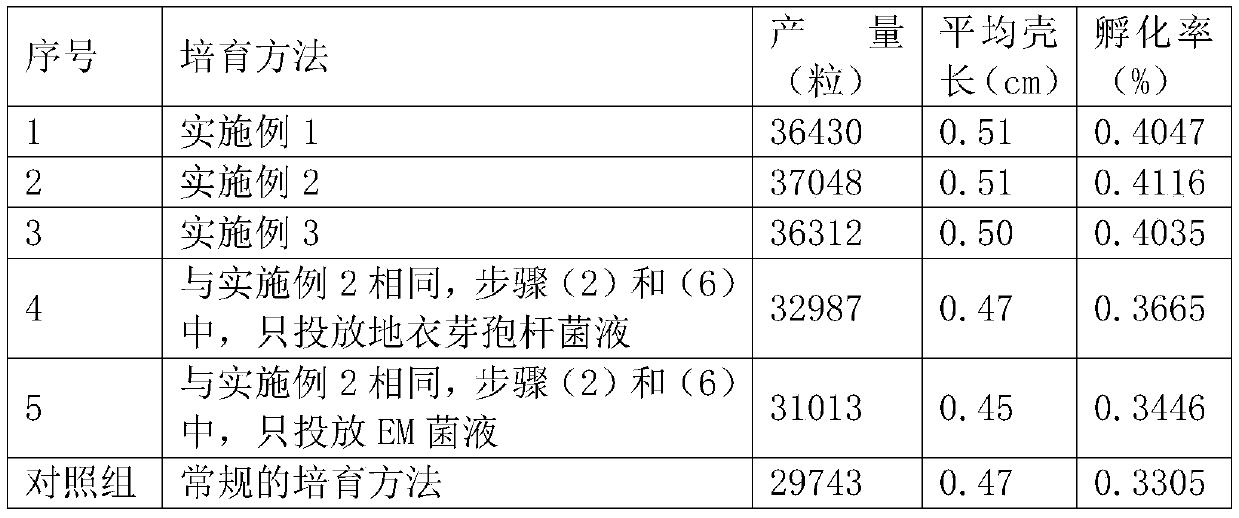Cultivation method for tripnenstes gratilla larvae
A cultivation method and technology of sea urchins, which are applied in the field of cultivating sea urchin seedlings of three rows of sea urchins, can solve problems such as difficult to meet the needs of artificial breeding, endanger marine ecology, and low hatching rate, achieve important economic and social values, and promote The effect of developing and improving the success rate
- Summary
- Abstract
- Description
- Claims
- Application Information
AI Technical Summary
Problems solved by technology
Method used
Image
Examples
Embodiment 1
[0023] A method for cultivating sea urchin seedlings in three rows of white spines, comprising the following steps:
[0024] (1) Set up a cement pool indoors as a nursery pond. The length, width, and height of the nursery pool are 2.5m×3.0m×1.0m, and an inlet and drainage system is installed. After disinfection, seawater is injected to a depth of 0.8m; the injected seawater has been sanded 4 times Filtered and sterilized by UV light.
[0025] (2) Select the fertilized eggs of three rows of sea urchins of high-quality Radix Acanthopanax and put them into the nursery ponds. The density of putting in is to put 1.5 million fertilized eggs per cubic meter of water body, that is, put 150×2.5×3.0×0.8=9 million in each nursery pond In the middle of the nursery pool, put 2 air heads per square meter, and the air volume is 20L / min for micro-inflation. The seawater in the nursery pool is controlled to have a pH value of 7, a salinity of 30, a temperature of 28°C and a DO (dissolved oxyge...
Embodiment 2
[0033] A method for cultivating sea urchin seedlings in three rows of Acanthus alba, the method is the same as in Example 1, and the distinguishing feature is that in step (2), the seawater in the seedling pond is controlled to have a pH value of 8.3, a salinity of 32, and a temperature of 30°C.
Embodiment 3
[0035] A method for cultivating sea urchin seedlings in three rows of Alpinia spinach, the method is the same as in Example 1, and the distinguishing feature is that in step (2), the seawater in the seedling pond is controlled to have a pH value of 9, a salinity of 35, and a temperature of 28°C.
[0036] Comparison of three-row sea urchin seedlings with different breeding methods
[0037] According to the specification of embodiment 1, seedling ponds and stocking density are set, and 6 seedling ponds are set. Experimental groups 1-5 respectively adopted different cultivation methods to cultivate three-row sea urchin seedlings of Alpinia sinensis. The control group adopted a conventional cultivation method, specifically referring to the cultivation method adopted in "Study on Artificial Cultivation Techniques of Sea Urchin Seedlings in Three Rows of White Acanthopanax" published in "Hebei Fishery" by Tang Heming in 2008. The 6 groups of experiments were all collected seedlings...
PUM
 Login to View More
Login to View More Abstract
Description
Claims
Application Information
 Login to View More
Login to View More - R&D
- Intellectual Property
- Life Sciences
- Materials
- Tech Scout
- Unparalleled Data Quality
- Higher Quality Content
- 60% Fewer Hallucinations
Browse by: Latest US Patents, China's latest patents, Technical Efficacy Thesaurus, Application Domain, Technology Topic, Popular Technical Reports.
© 2025 PatSnap. All rights reserved.Legal|Privacy policy|Modern Slavery Act Transparency Statement|Sitemap|About US| Contact US: help@patsnap.com

